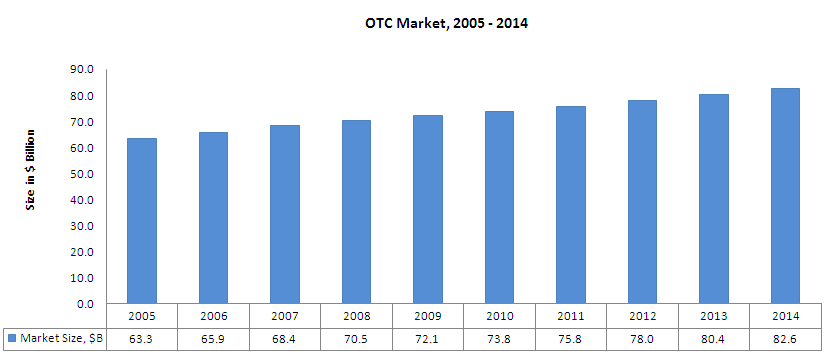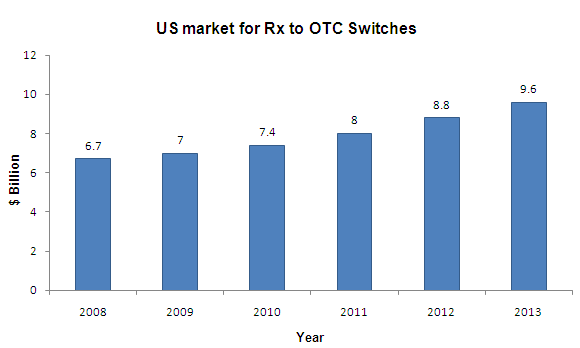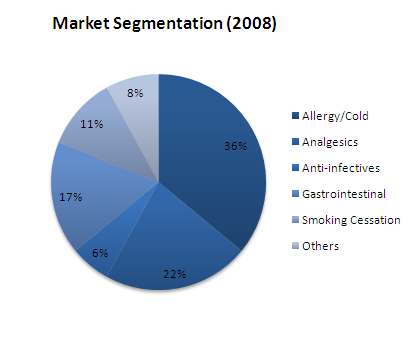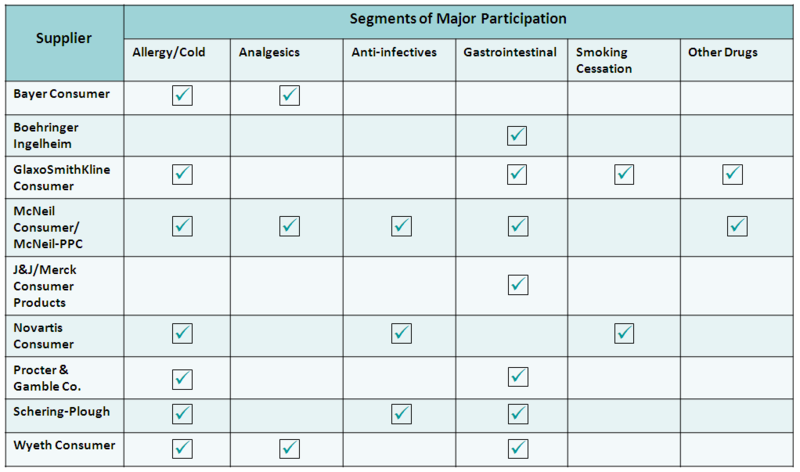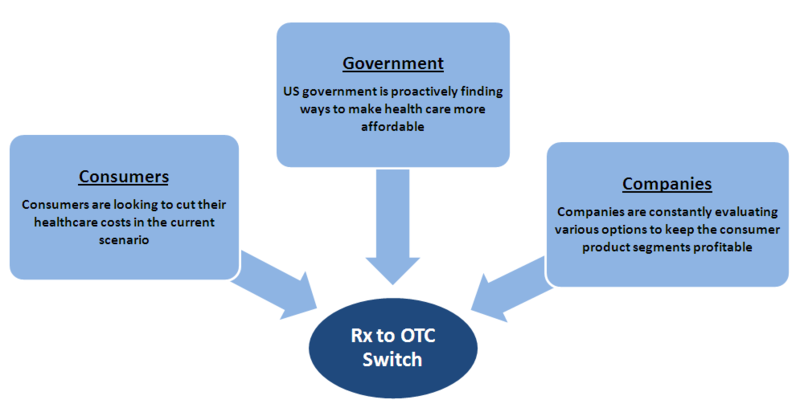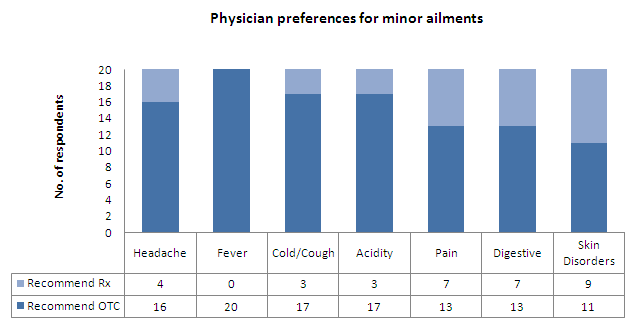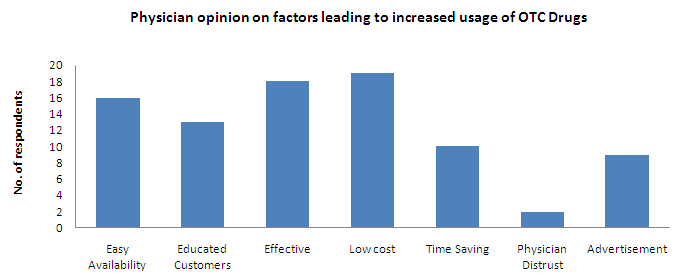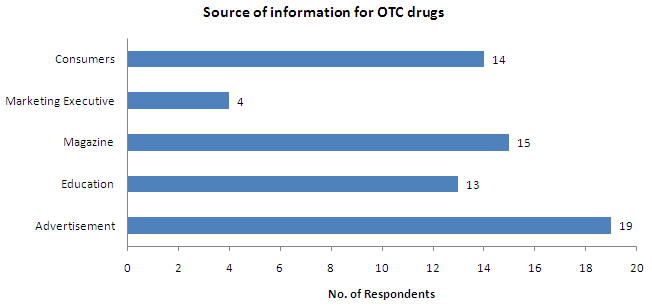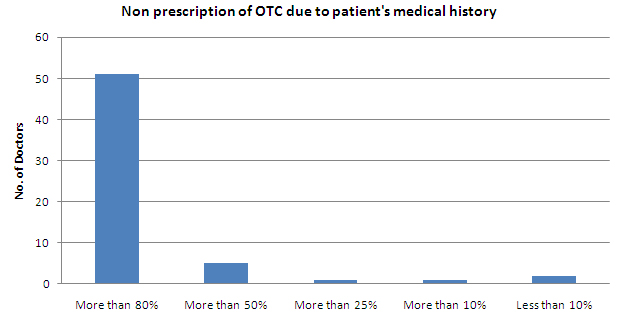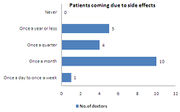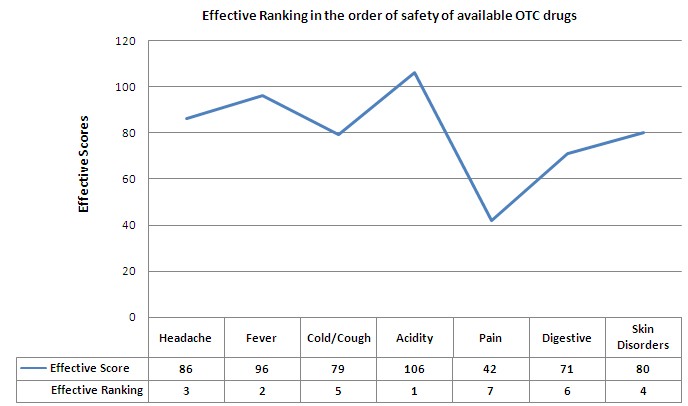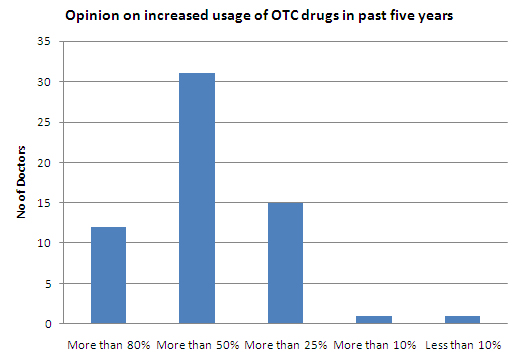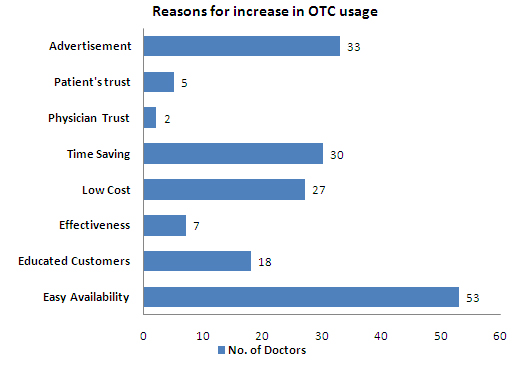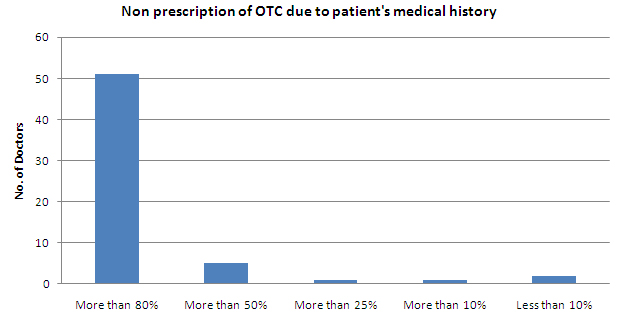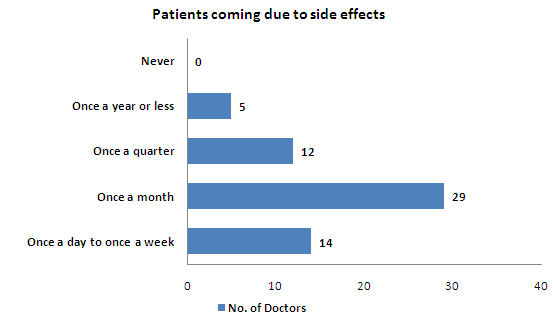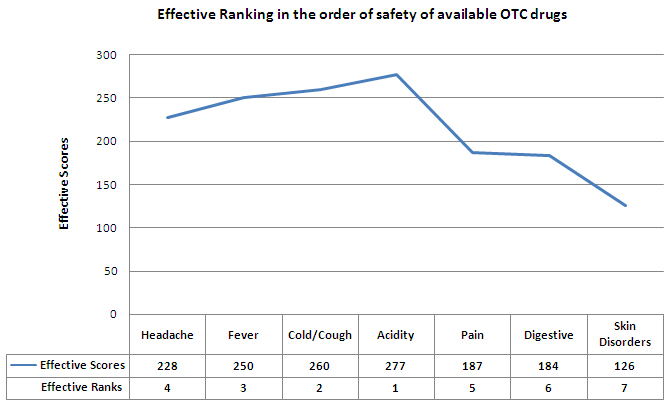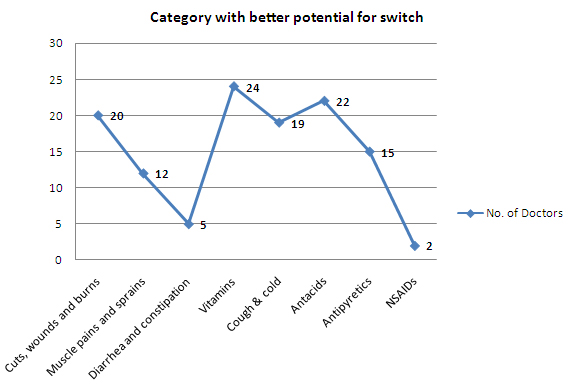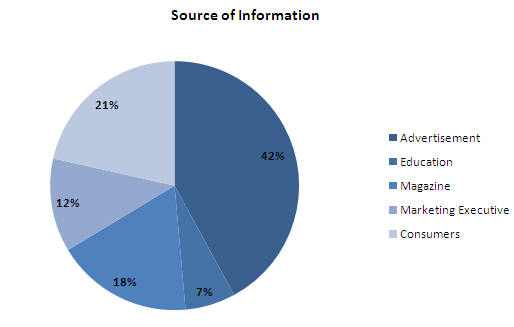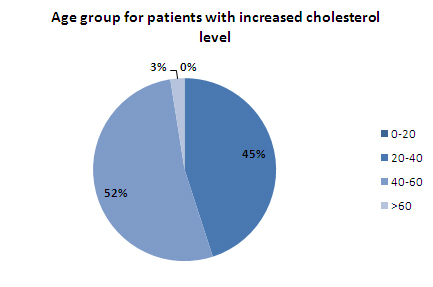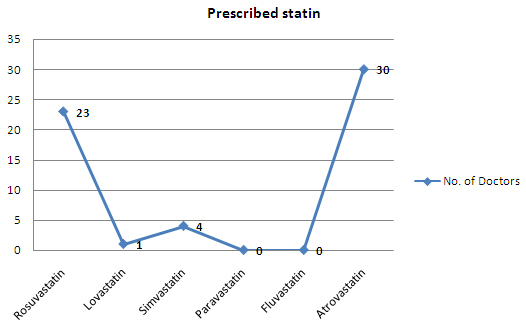Rx to OTC Switch-Market Analysis
Contents
Introduction
Over-the-counter (OTC) drugs are medicines that may be sold directly to a consumer without a prescription from a healthcare professional, and are commonly used to treat symptoms of common illnesses that may not require the direct supervision of a physician.
- For a medicine to be granted OTC status, it must have a wide safety margin and be effective, and must bear understandable labeling to ensure proper use
- More than 700 OTC products on the market today use ingredients or dosages, that were available only by prescription, less than 30 years ago
- Rx to OTC switch refers to the transfer of proven prescription drugs (Rx) to non-prescription, over-the-counter (OTC) status. Rx to OTC switch is a data-driven, scientifically rigorous, and highly regulated process that allows consumers to have OTC access to a growing range of medicines
There are two ways in which drugs are commonly switched as approved by FDA in US :
- The OTC Drug Review
- Began in 1972
- Ongoing assessment of the safety and effectiveness of all nonprescription drugs
- Panels of non-government experts review active ingredients in marketed OTC drug products to determine whether they can be classified as safe and effective
- About 40 former prescription-only drug ingredients have been switched by this process
- New drug application (NDA) process
- Manufacturers submit data to the FDA showing the drug is appropriate for self-administration.
- The submission includes studies showing that the product's labeling can be read, understood, and followed by the consumer without the guidance of a health care provider
- Some drugs are approved initially as OTC drugs, but most are first approved for prescription use and later switched to OTC
Rx and OTC Regulation
The FDA process for drug approval is given below
- NDA - New Drug Application
- ANDA - Abbreviated New Drug Application
- Full NDA- For a new dosage or formulation such as lower strength than Rx version (for a medication currently available by prescription)
- Supplemental NDA – For a product for which the manufacturer already holds an approved NDA or holds an abbreviated NDA for a closely related product
- Abbreviated NDA – For products that are identical to an existing prescription product
- The switch to OTC is done in a partial or total way. Most switches are partial, a version of the active ingredient remains available on prescription while a specific indication, strength, or dosage form becomes available through the(new NDA) switch application. On the other hand some switches are full, no prescription version of the active ingredient remains which becomes available through (NDA supplement) switch application.
Source:FDA , Nonprescription Product Therapeutics, Section 1, Chapter 2
Prescription Drugs - Branded
Once a drug has been discovered, the drug manufacturer must test the drug in laboratory and on animals. If it proves effective, the drug is tested in humans to see if it safe and effective. Once it is demonstrated to be safe, the manufacturer sends a New Drug Application (NDA) to the FDA to apply for approval. Next come tests in humans to see if the drug is safe and effective when used to treat or diagnose a disease.
New Drug Application (NDA)
The NDA application is the vehicle through which drug sponsors formally propose that the FDA approve a new pharmaceutical for sale and marketing in the U.S. The data gathered during the animal studies and human clinical trials of an Investigational New Drug (IND) become part of the NDA.
The goals of the NDA are to provide enough information to permit FDA reviewer to reach the following key decisions:
- Whether the drug is safe and effective in its proposed use(s), and whether the benefits of the drug outweigh the risks.
- Whether the drug's proposed labeling (package insert) is appropriate, and what it should contain.
- Whether the methods used in manufacturing the drug and the controls used to maintain the drug's quality are adequate to preserve the drug's identity, strength, quality, and purity.
The documentation required in an NDA is supposed to tell the drug's whole story, including what happened during the clinical tests, what the ingredients of the drug are, the results of the animal studies, how the drug behaves in the body, and how it is manufactured, processed and packaged.
NDAs include:
- The drug's test results
- Manufacturing information to demonstrate the company can properly manufacture the drug.
- The company's proposed label for the drug, which should include information about the drug, its uses, and possible risks.
The FDA approves drugs if their benefits outweigh any risks in taking them. Once a drug is approved, its manufacturer can market and then sell it in the U.S. In approving the drug, the FDA also takes into account the proposed name for it. To protect the safety of the public, it is important that the name not be similar to that of another drug product to prevent against mix-ups. FDA's Division of Medication Error Prevention and Analysis reviews the names.
Source:FDA,Pharmacy.About
Prescription Drugs – Generic
Generic drugs are also known as copycat drugs. They are exact replicas of the branded drugs and typically go by their chemical name-Lipitor's generic is called atorvastatin, for example. They do not have a patent. The manufacturers of generic drugs provide an abbreviated new drug application (ANDA) to the FDA to receive approval. Since there is already a drug on the market to help consumers, the approval time for generic drugs is typically longer. The Office of Generic Drugs (OGD), which is a department within the FDA, approves generic drugs.
An Abbreviated New Drug Application (ANDA) is submitted to the FDA when seeking review and approval for a generic drug product. The application is submitted to the FDA's Center for Drug Evaluation and Research, Office of Generic Drugs. If approved, the generic drug may be manufactured and sold in the U.S. market.
Generic drug applications are not typically required to include preclinical (animal) and clinical (human) data to establish safety and effectiveness. An applicant submitting an ANDA must scientifically demonstrate that its product is bioequivalent to the previously approved innovator or brand name drug.
Source:Pharmacy.about1, Pharmacy.about2
FDA requires generic drugs to have the same quality and performance as brand name drugs.
- When a generic drug product is approved, it has met rigorous standards established by the FDA with respect to identity, strength, quality, purity, and potency. However, some variability can and does occur during manufacturing, for both brand name and generic drugs. When a drug, generic or brand name, is mass-produced, very small variations in purity, size, strength, and other parameters are permitted. FDA limits how much variability is acceptable.
- Generic drugs are required to have the same active ingredient, strength, dosage form, and route of administration as the brand name product. Generic drugs do not need to contain the same inactive ingredients as the brand name product.
- The generic drug manufacturer must prove its drug is the same as (bioequivalent) the brand name drug. For example, after the patient takes the generic drug, the amount of drug in the bloodstream is measured. If the levels of the drug in the bloodstream are the same as the levels found when the brand name product is used, the generic drug will work the same.
- Through review of bioequivalence data, FDA ensures that the generic product performs the same as its respective brand name product. This standard applies to all generic drugs, whether immediate or controlled release.
- All generic manufacturing, packaging, and testing sites must pass the same quality standards as those of brand name drugs, and the generic products must meet the same exacting specifications as any brand name product. In fact, many generic drugs are made in the same manufacturing plants as brand name drug products.
Source: FDA
OTC - Branded & Prescription Drugs
The FDA's Office of Drug Evaluation IV, Over-the-Counter Drug Products reviews OTC drugs. A Nonprescription Drug Advisory Committee, comprised of up to 14 independent experts selected by the FDA commissioner, assists the FDA in reviewing issues surrounding OTC drugs, including switching drugs from prescription to non-prescription status.
Instead of reviewing the labels and ingredients of all 300,000 OTC drugs now being marketed, the FDA focuses on about 80 different therapeutic classes of drugs, such as analgesics, antacids, antimicrobial, antiperspirants, dental and cough/cold medicines.
The FDA publishes an OTC drug monograph for each category of drug in the Federal Register. Drug monographs serve as a cook book, or list of recipes, that include acceptable ingredients, formulations, dosages and labeling for each category of drug.The monograph explains the types of ingredients that may be used to treat certain diseases or conditions without a prescription, the appropriate dose and instructions for use, and labeling.
Once a monograph is adopted, companies may develop and market an OTC product without pre-approval from the FDA. Products that do not adhere to the monograph must be reviewed through FDA’s New Drug Application process.A drug company can also petition the FDA to deviate from the ingredient or labeling requirements of an OTC monograph.
- Over-the-counter (OTC) drugs are drugs that the FDA has decided are safe and appropriate for use without the supervision of a health care professional and can be purchased without a prescription.
- Products conforming to a monograph may be marketed without further FDA clearance, while those that do not must undergo separate review and approval through the "New Drug Approval System".
- OTC products that meet a monograph's requirements may be marketed without FDA review. OTC products that do not fit under an existing monograph must be approved under an application like the applications for prescription products.
Source:Pharmacy.About1,Pharmacy.About2
Rx to OTC Switch – Regulatory Process
There are 2 regulatory pathways for getting approval for OTC drugs (Rx to OTC switch and Direct to OTC)
- OTC New Drug Application (NDA)
- OTC Drug Monograph
Rx-to-OTC switches
The applications differ based on whether the manufacturer wants to switch to OTC completely or partially.
- Full switch (NDA supplement)
- Partial switch (new NDA)
Source:FDA
Direct-to-OTC
- OTC Monographs
- OTC NDA
Source:OTC Regulation in Different Countries
FDA Applications
- An efficacy supplement should be submitted to an approved NDA for a prescription product if the sponsor plans to switch the drug product covered under the NDA to OTC marketing status in its entirety without a change in the previously approved dosage form or route of administration.
- An NDA 505(b)(1) should be submitted if the sponsor is proposing to convert some but not all of the approved prescription indications to OTC marketing status.
- An original NDA (505)(b)(1) or 505(b)(2) needs to be submitted if the sponsor plans to market either a new product OTC whose active substance, indication, or dosage form has never previously been marketed OTC.
OTC drug review
The OTC drug review was established to evaluate the safety and effectiveness of OTC drug products marketed in the United States before May 11, 1972. It is a three-phase public rulemaking process (each phase requiring a Federal Register publication) resulting in the establishment of standards (monographs or non-monographs) for an OTC therapeutic drug category.
- First phase
- The first phase was accomplished by advisory review panels. The panels were charged with reviewing the ingredients in nonprescription drug products to determine whether these ingredients could be generally recognized as safe and effective for use in self-treatment. They were also charged with reviewing claims and recommending appropriate labeling, including therapeutic indications, dosage instructions, and warnings about side effects and preventing misuse.
- According to the terms of the review, the panels classified ingredients in three categories as follows:
- Category I: generally recognized as safe and effective for the claimed therapeutic indication;
- Category II: not generally recognized as safe and effective or unacceptable indications;
- Category III: insufficient data available to permit final classification
- First phase
- Second phase
- The second phase of the OTC drug review was the agency’s review of ingredients in each class of drugs, based on the panel’s findings, on public comment, and on new data that may have become available. The agency, in turn, publishes its conclusions in the Federal Register in the form of a tentative final monograph. After publication of the tentative final monograph, a period of time is allotted for objections to the agency’s proposal or for requests to be submitted for a hearing before the Commissioner of FDA.
- Second phase
- Third phase
- The publication of final regulations in the form of drug monographs is the third and last phase of the review process. The monographs establish conditions under which certain OTC drug products are generally recognized as safe and effective.
- Third phase
Clinical Trials : Rx-to-OTC
Clinical trials are not a compulsory requirement for Rx-to-OTC switches, but most switch applications include new clinical trial data for the non-prescription indication and almost all the switch applications include label comprehension studies and/or actual use studies to demonstrate that the medicine can be used safely and effectively in the consumer target population. Additional standard efficacy and safety clinical trials are to prove the drug can be used safely in an OTC setting.
FDA’s Center for Drug Evaluation and Research (CDER) defines OTC drug actual use study as “a controlled experiment in which a prescription drug or unapproved new drug is used by subjects under OTC-like conditions.” OTC studies are intended to support a significant change in labelling for the drug. These studies are considered the most important in assessing a drug’s appropriateness for a switch. The main Objectives of an Rx-to OTC study fall into four main categories:
- Safety (prescription safety demonstrated by previous trials)
- Comprehension (demonstrated by label comprehension studies)
- Self-selection and de-selection
- Compliance as the core issue
If the drug has a good safety profile, shown by the studies done to support its marketing as a prescription drug, and if the drug meets the specific criteria for switching which includes ability of selection or de-selection by consumer, there is relatively good chance that FDA will approve it for OTC use.
Source:FDA, Compliance Online
Market Overview
OTC Market
| Time Period | CAGR |
| 2005-2009 | 3.3% |
| 2009-2014 | 2.7% |
| 2005-2014 | 3.0% |
Rx vs. OTC Market
Total Pharmaceutical Market by Country, 2009 ($B)
| Country | Rx Market | OTC Market | Total Pharma Market | OTC as % of Total Pharma Market |
| United States | 214 | 18 | 232 | 7.8 |
| Japan | 56 | 11 | 67 | 16.4 |
| Germany | 35 | 5 | 40 | 12.5 |
| France | 32 | 4 | 36 | 11.1 |
| China | 16 | 5 | 21 | 23.1 |
| United Kingdom | 17 | 3 | 20 | 15.0 |
| Russia | 13 | 3 | 16 | 18.8 |
| Brazil | 10 | 2 | 12 | 16.7 |
| Mexico | 9 | 2 | 11 | 18.1 |
| India | 6 | 3 | 9 | 33.3 |
Source: Kalorama Information
Rx to OTC Switches
- CAGR for 2008-2013 is 9.4%
Major OTC Players
Sales Data for selected Rx to OTC Switches, USA
| S.No | Switched Drug | Manufacturer/Marketer | Drug Category | Switch Year | First 12-Month Sales (in $M) |
| 1 | Alli | Glaxo SmithKline Consumer Healthcare | Weight Loss Aid | 2007 | 80 |
| 2 | MiraLax | Schering-Plough Healthcare | Gastrointestinal | 2006 | 40 |
| 3 | Prilosec OTC | Procter & Gamble | Gastrointestinal | 2003 | 130 |
| 4 | Claritin | Schering-Plough Healthcare | Allergy | 2002 | 380 |
| 5 | Nicoderm CQ | Glaxo SmithKline Consumer Healthcare | Smoking Cessation | 1996 | 160 |
| 6 | Nicorette | Glaxo SmithKline Consumer Healthcare | Smoking Cessation | 1996 | 195 |
| 7 | Rogaine | McNeil Consumer Healthcare | Hair Loss | 1996 | 180 |
| 8 | Pepcid AC | Johnson & Johnson- Merck Consumer Pharmaceuticals Co. | Gastrointestinal | 1995 | 200 |
| 9 | Zantac 75 | Boehringer Ingelheim Consumer Healthcare Products | Gastrointestinal | 1995 | 140 |
| 10 | Aleve | Bayer Consumer Care | Analgesic | 1994 | 110 |
Source:Company Websites, Press Releases and Journals
Factors Affecting Rx to OTC Switch
Trends in Rx to OTC Switches
Rx-to-OTC Switches Since 2000
| S.No | Ingredient | Product Category | Date of OTC Approval | Product Examples | Company |
| 1 | ibuprofen (NDA) | migraine | 25/02/2000 | Motrin Migraine Pain | McNeil Consumer Healthcare |
| 2 | docosanol (NDA) | cold sore/fever blister | 25/07/2000 | Abreva Cream | Avanir Pharmaceuticals |
| 3 | famotidine, calcium carbonate, | heartburn, | 17/10/2000 | Pepcid Complete | J&J/Merck |
| magnesium hydroxide (NDA) | acid indigestion | ||||
| 4 | butenafine hydrochloride (NDA) | athlete's foot, jock itch, ringworm | 7/12/2001 | Lotrimin Ultra | Schering-Plough |
| 5 | ibuprofen, pseudoephedrine HCl, | analgesic/decongestant | 18/04/2002 | Children’s Advil Cold | Wyeth |
| suspension for pediatric use (NDA) | |||||
| 6 | guaifenesin extended-release tablet (NDA) | expectorant | 12/7/2002 | Mucinex | Adams Respiratory Therapeutics |
| 7 | nicotine polacrilex troche/lozenge (NDA) | smoking cessation | 31/10/2002 | Commit | GlaxoSmithKline |
| 8 | loratadine (NDA) | antihistamine | 27/11/2002 | Claritin Tablets, Claritin RediTabs, Claritin Syrup | Schering-Plough |
| 9 | loratadine, pseudoephededrine sulfate (NDA) | antihistamine/ | 27/11/2002 | Claritin-D 12 Hour Extended Release Tablets, | Schering-Plough |
| decongestant | |||||
| 10 | omeprazole magnesium | acid reducer to treat frequent heartburn | 20/06/2003 | Prilosec OTC | Procter & Gamble |
| 11 | loratadine (NDA) | hives relief | 15/11/2003 | Claritin hives relief | Schering-Plough |
| diphenhydramine citrate & ibuprofen (NDA); diphenhydramine HCl & ibuprofen potassium (NDA) | analgesic sleep-aid | 21/12/2005 | Advil PM | Wyeth | |
| 12 | ecamsule (combined with avobenzone and octocrylene (NDA) | sunscreen | 21/07/2006 | Anthelios SX | L’Oreal |
| 13 | levonorgestrel (NDA) | contraceptive | 24/08/2006 | Plan B | Duramed |
| polyethylene glycol 3350 (NDA) | laxative | 6/10/2006 | MiraLAX | Schering-Plough | |
| 14 | ketotifen (NDA) | antihistamine eye drops | 19/10/2006 | Zaditor | Novartis |
| 15 | orlistat (NDA) | weight loss aid | 7/2/2007 | alli | GlaxoSmithKline |
| cetirizine HCl & pseudoephedrine HCl (NDA) | antihistamine/ | 9/11/2007 | Zyrtec-D | McNeil | |
| 16 | decongestant | ||||
| 17 | cetirizine HCl (NDA) | antihistamine, hives relief | 16/11/2007 | Zyrtec | McNeil |
| lansoprazole (NDA) | acid reducer to treat | 18/05/2009 | Prevacid 24 HR | Novartis | |
| 18 | frequent heartburn | ||||
| 19 | levonorgestrel (NDA) | contraceptive | 10/7/2009 | Plan B One Step | Duramed |
| omeprazole and sodium | acid reducer to treat | 1/12/2009 | Zegerid OTC | Schering-Plough | |
| 20 | bicarbonate (NDA) | frequent heartburn |
- Blue highlighted drugs are patent-protected
- Purple highlighted drugs are under FDA exclusivity period
Rx to OTC Switches before patent expiry
| S.No | Product Examples | Company | Date of OTC Approval | Patent Expiry | FDA Exclusivity | Patent Number |
| 1 | Abreva Cream | Avanir Pharmaceuticals | 25/07/2000 | 28/04/2014 | -- | 4874794 |
| 2 | Pepcid Complete | J&J/Merck | 17/10/2000 | 15/10/2000 | -- | 4283408 |
| 3 | Mucinex | Adams Respiratory Therapeutics | 12/7/2002 | 28/04/2020 | -- | 6372252 |
| 4 | Commit | GlaxoSmithKline | 31/10/2002 | 21/08/2010 | -- | 5110605 |
| 5 | Prilosec OTC | Procter & Gamble | 20/06/2003 | 15/11/2019 | -- | 5690960, 5753265, 5817338, 5900424, 6403616, 6428810 |
| 6 | Claritin hives relief | Schering-Plough | 15/11/2003 | 19/06/2002 | -- | 4282233 |
| 7 | Anthelios SX | L’Oreal | 21/07/2006 | 24/12/2013 | -- | 5587150 |
| 8 | Plan B | Duramed | 24/08/2006 | -- | 24/08/2009 | -- |
| 9 | MiraLAX | Schering-Plough | 6/10/2006 | -- | 6/10/2009 | -- |
| 10 | alli | GlaxoSmithKline | 7/2/2007 | 6/1/2018 | 7/2/2010 | 6004996 |
| 11 | Zyrtec-D | McNeil | 9/11/2007 | 10/6/2022 | -- | 6469009, 6489329, 7014867, 7226614 |
| 12 | Zyrtec | McNeil | 16/11/2007 | 2/7/2018 | -- | 6455533 |
| 13 | Prevacid 24 HR | Novartis | 18/05/2009 | -- | 18/05/2012 | -- |
| 14 | Plan B One Step | Duramed | 10/7/2009 | -- | 10/7/2012 | -- |
| 15 | Zegerid OTC | Schering-Plough | 1/12/2009 | 15/07/2016 | -- | 6489346, 6645988, 6699885, 7399772 |
- Purple highlighted drugs are under FDA exclusivity period
Trend Analysis
- 11 out of 22 recent drugs (50%) which switched from Rx to OTC were patent protected
- 4 out of 22 recent drugs (18.2%) which switched from Rx to OTC were under FDA exclusivity period
- 13 out of 22 recent drugs (59%) were switched from Rx to OTC before their patent or FDA exclusivity expiry. 2 drugs switched after the expiry of patents
- 6 out of these 13 drugs made a switch more than 10 years before expiry
- 5 out of these 13 drugs made a switch between 3 to 10 years before expiry
Potential Drugs for Rx-to-OTC Switch
| S.No | Drug | Patent Expiry Date | Expected Switch Year | US Patent Numbers |
| 1 | Allegra | 14/3/2017 | 2012 | 5578610, 6037353, 6187791, 6399632, 7138524 |
| 2 | Clarinex | 1/12/2018 | >2013 | 6514520, 7211582, 7214683, 7214684 |
| 3 | Crestor | 17/6/2022 | >2014 | 6858618, 6316460, 7030152, RE37314 |
| 4 | Lescol | 12/6/2012 | >2014 | 5356896, 5354772, |
| 5 | Lipitor | 8/1/2017 | >2014 | 5969156, 4681893, 5273995, 5686104, 5969156, 6126971, RE40667 |
| 6 | Pravachol | 22/10/2014 | >2014 | 5622985 |
| 7 | TriCor | 21/2/2023 | >2014 | 7276249, 5145684, 6277405, 6375986 , 6652881, 7037529, 7041319, 7320802 |
| 8 | Vytorin | 25/4/2017 | >2014 | RE37721, 5846966, |
| 9 | Zetia | 25/7/2022 | >2014 | 7030106, 5846966, 7612058, RE37721 |
| 10 | AcipHex | 8/5/2013 | 2013 | 5045552 |
| 11 | Nexium | 25/11/2018 | >2014 | 7411070, 5690960, 5714504, 5877192, 5900424, 6147103, 6166213, 6191148, 6369085, 6428810, 6875872 |
| 12 | Protonix | 30/3/2025 | 2010 | 7553498, 4758579, 7544370, 7550153 |
| 13 | Zofran | 7/12/2026 | >2014 | 7544370, 4758579, 7550153, 7553498 |
| 14 | Propecia | 5/11/2013 | 2011 | 5571817, 5547957, 5886184 |
| 15 | Imitrex | 10/3/2014 | >2010 | 5554639, 5307953, 5705520 |
| 16 | Actonel | 10/12/2018 | >2014 | 6165513, 5583122, 6096342 |
| 17 | Boniva | 2/9/2014 | >2014 | 5662918, 4927814 |
| 18 | Fosamax | 17/1/2019 | >2014 | 6225294, 5462932, 5994329, 6015801 |
| 19 | Evista | 10/3/2017 | >2014 | 6894064, 6797719, 6458811, 5393763, 5457117, 5478847, 5811120, 5972383, 6906086, RE38968, RE39049, RE39050 |
| 20 | Detrol | 11/5/2020 | >2014 | 5382600, 6630162, 6770295, 6911217 |
| 21 | Ditropan | 22/11/2015 | >2014 | 5674895, 5840754, 1 5912268, 6262115, 6919092 |
| 22 | Cialis | 26/4/2020 | >2014 | 7182958, 5859006, 6140329, 6821975, 6943166 |
| 23 | Levitra | 31/10/2018 | >2014 | 6362178, 7696206 |
| 24 | Viagra | 22/10/2019 | >2014 | 6469012, 5250534 |
US Market Survey - Physicians Preferences and Insights
Objectives of Survey
- To find Physician preferences for OTC drugs in comparison to prescription drugs
- To find insights on OTC drugs market and usage
- To understand the effectiveness of different sources of marketing
Research Methodology
The research instrument used was a questionnaire survey administered to collect empirical data. The physician responses were kept confidential to encourage openness and disclosure. The respondents rated the questions on Yes or No, ticked the relevant choices from the options available and ranked the options on a numerical scale. All the responses were coded using a binary system logic and analysis was done to derive insights there after.
Sample Size and Screening Criteria
| Gender | Sample Size |
| Male | 18 |
| Female | 2 |
| Total Physicians | 20 |
| Screening Criteria | |
| Primary Medical Specialty | General Physician/Family Practice |
| No. of years in practice | 10 |
| No. of patients consulting per month | 150 |
Survey Results
- All the respondents would recommend an OTC drug for fever
- About 95% of the doctors feel that the usage of OTC drugs has increased in the past five years
- About 85% of them would do so for other minor ailments like cold/cough and acidity
- Low cost, effective and easy availability are selected as the major factors that resulted in increased usage of OTC drugs
- All the respondents feel it is important to prescribe a drug that minimizes patients' out-of-pocket costs, while choosing between equally effective and safe medications
- Advertisement is the major source of information on OTC drugs for most of the respondents
- Only 30% of respondents replied in positive when asked about permitting marketing executives to market OTC products through them
- About 63% of the respondents reported the growth rate of OTC usage during 2005-2010 between 25% - 50% and equal percentage of respondents stated that patients are trusting OTC drugs more than they used to do before as the prime reason for the growth
- Less than 50% of the patients are not prescribed OTC due to their medical history
- The case of patients coming to the doctor due to side effects from OTC drugs happens once a month
- About 45% of the respondents feel that non-prescription of drugs is not a serious problem
- 85% of the doctors feel that the information on the label of OTC drugs is sufficient for the patients, in order to take OTC medicines
- 50% of the doctors feel that more OTC drugs should be included under Medicare/insurance coverage
The effective ranking of the ailments in the order of safety of available OTC drugs is as follows:
To see the calculation of the effective scores and effective ranking, click on this link
Indian Market Survey - Physicians Preferences and Insights
Objectives of the Survey
The reason for carrying out this research is to determine the scope of potential switch of prescription drugs to over the counter drugs in the Indian pharma industry. The study is particularly focused at the scope of making statins(a drug for reducing cholesterol level) available over-the-counter. The study aims to understand how successful a switch would be, and if it is safe for such drugs to be made available without prescription. The study also aims at determining the marketing pattern of over the counter drugs, and how it can be improved in future.
The objectives for the survey are :
- To understand the effectiveness of OTC drug marketing campaigns in India
- To understand the source of information for the OTC drugs among doctors
- To explore the potential of switch from Rx to OTC drugs
- To gauge the current prescription pattern of statins in India
- To identify if statins can be switched to OTC
Research Methodology
The research instrument used was a questionnaire survey administered to collect empirical data. The physician responses were kept confidential to encourage openness and disclosure. The respondents rated the questions on Yes or No, ticked the relevant choices from the options available and ranked the options on a numerical scale. All the responses were coded using a binary system logic and analysis was done to derive insights there after.
Sample Size and Screening Criteria
Screening Criteria
| Screening Criteria | |
| Medical Specialty | General Physician, Consulting Physician, Gynaecologist, Dermatologist, Cardiologist, Pediatrician |
| No. of years in practice | 10 |
| No. of patients consulting per month | 150 |
Sample Size
| Gender | Sample Size |
| Male | 44 |
| Female | 16 |
| Total Physicians | 60 |
| Medical Specialty-wise Breakup | |
| General Physician | 17 |
| Consulting Physician | 9 |
| Gynecologist | 9 |
| Dermatologist | 4 |
| Cardiologist | 12 |
| Pediatrician | 6 |
| Geographywise Breakup | |
| Mumbai | 15 |
| Hyderabad | 15 |
| Delhi NCR | 14 |
| Bangalore | 16 |
Survey Results
- 97% of the Indian doctors feel that the usage of OTC drugs has increased in the past 5 years
- Indian doctors feel that the usage of OTC drugs has increased by more than 50% in the past 5 years
- Ease in the availability of OTC drugs, Advertisements and Saving time are the major reasons for increase in the usage of OTC drugs
- Headache, Cold/Cough and acidity are the most common ailments for which physicians prefer giving an OTC drug
- More than 80% of the patients are not prescribed OTC drugs beacuse of their prior medical history
- Only 13% of the doctors feel that the information on the labels of OTC drugs is sufficient
- 98% of the doctors feel that drug-drug interactions might be a potential danger for OTC drugs
- 48% of the patients come once a month to doctor due to side effects caused by OTC drugs
- 95% of the doctors feel that the problem of taking OTCs in India is serious
The effective ranking of the ailments in the order of safety of available OTC drugs is as follows:
To see the calculation of the effective scores and effective ranking, click on this link
- 72% of the doctors see an opportunity for Rx-to-OTC switch in Indian pharma market
- Drugs relating to Vitamins, Antacids, Cuts, wounds and burns & Cold/Cough have a better potential to do well as an OTC drug
Effectiveness of marketing campaigns
- Advertisements are a major source of information for Indians on OTC drugs
- Only 23% of the doctors permit marketing executives to market OTC products through them
- Quality is the most important factor affecting the choice of a drug
Results on Statins
- More than 50% of the patients with high cholesteral level fall in the age group of 40-60 years
- 73% of the patients with high cholesteral level are prescribed Statin by doctors
- Atrovastatin and Rosuvastatin are prescribed more than 90% of the times (whenever statins are prescribed) by doctors to patients with high cholesterol level
- Sale and effectiveness of the drug, Manufacturer of the drug and Patient type are the major factors for choosing any type/brand of statin
- Only 25% of the doctors feel that statins safe to be made available as OTC drugs for low- to-moderate risk group

